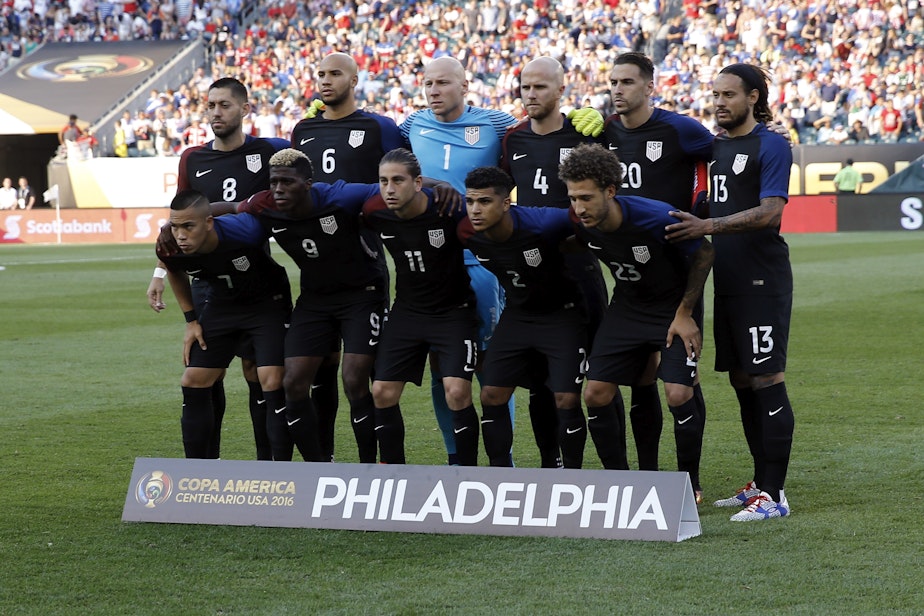Does Seattle-area youth soccer have a white privilege problem?

The eyes of the soccer world are on Seattle this week for the COPA America Tournament. On Tuesday, a diverse crowd poured into CenturyLink field to watch the world’s top-ranked men’s national team, Argentina, take on Bolivia.
The U.S. Men's National Team plays in Seattle in a quarterfinal match Thursday night. Millions are expected to watch the game in the U.S.
But Seattle is also in the global spotlight over American soccer's white privilege problem.
Doug Andreassen loves soccer like you love ice cream. He's the former president of Washington Youth Soccer; these days he chairs U.S. Soccer’s diversity task force.
That job has gotten him into hot water this month with some U.S. soccer fans. He featured prominently in a Guardian article about U.S. soccer with the headline: “It’s only working for the white kids.”
"I have received a lot of email back from people and a lot of hate mail back from people as well: ‘How dare you make this accusation? How dare you put this in headlines?’” Andreassen said. “And I say, let's talk about it."
Andreassen's job is to help clubs and players of all backgrounds become better integrated into U.S. Soccer for two big reasons: One is to make the United States more competitive in the world's game, and the second goal is equity.
But Andreassen said there's a lot of work to do, including here in Washington state.
"We've had games where a Hispanic team has played a Caucasian team. And the ref has told the Spanish [speaking] coach, ‘You have to speak English,’” Andreassen said. “That's not in the handbook."
Andreassen has many stories like that. And he told me it's time for U.S. Soccer to make some big changes to add more diversity. He points to the fact that the men’s team has not yet won a World Cup, the biggest international tournament.
“With a nation of 330 million plus, you would think that at some point United States should be able to win the World Cup,” he said.
More diversity he said will allow the U.S. to get players that have more creativity on the field, and that ultimately will improve the men's and women's team. The women don’t get a pass, even though they won the World Cup last summer and twice before.
“We have the same issue in the women's game as we do the men's,” he said. “Look at the last picture when they won the World Cup: Does that picture represent America? I would say no.”
Andreassen thinks it’s important that U.S. Soccer looks more like America. “America is diverse and I think it's critical that we knock on the door of white privilege,” he said.
The problem isn’t just with the national teams, Andreassen said there are obstacles to diversity in our state’s local programs.
For example, he remembers an instance seven years ago where a local community leader in Tacoma called him up to ask how to start a team with a group of Hispanic kids. Andreassen told the coach to join a club.
“And then began the odyssey,” Andreassen said.
He said the clubs weren’t very accepting of Hispanics in this case and would give the coach information only in English, which he had difficulty reading. Andreassen said it was difficult for him to get his one team together.
That coach – Tony Echaniz – went on to form his own youth club, Tacoma United.
“Today I'm proud to say, seven years later, he's got about 26 teams, mostly Hispanic, in his club now that we've been able to assist and help through the system,” Andreassen said. “So as I look at what I do for the under-served community, I always keep in mind this particular club that's down in Tacoma.”
Language isn’t the only barrier to bringing diverse youth into the formal soccer ranks. Andreassen said money is one of the prime issues.
“Many of these parents are immigrants to this country and they're working one, two, sometimes three jobs and they don't have the income to pay for club fees for their kids to play sports,” he said.
Club fees can be from $1,000 - $5,000 according to Andreassen, and that doesn’t necessarily include coaches’ pay, traveling, field rentals, etc.
Andreassen works with schools to get cheaper fields and referees to get discounts to help combat the problem.
“What we're really talking about here is equity – we want social equity for soccer across the board,” he said.
Meantime, the U.S. Men’s team is hoping to get through to the semi-final round in the Copa tournament, but nobody expects them to win. Not this year, anyway.

